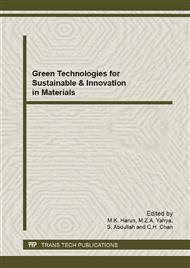[1]
D.M. Chien, N.N. Viet, N.T. Kieu Van, and N.T. Phuong Phong, Characteristics modification of TiO2 thin films by doping with silica and alumina for self-cleaning application, J. Experimental Nanoscience, 4 (2009) 221-232.
DOI: 10.1080/17458080902920506
Google Scholar
[2]
T.A. Salleh, and V.K. Gupta, Photo-catalyzed degradation of hazadrdous dye methyl orange by use of a composite catalyst consisting of multi-walled carbon nanotubes and titanium dioxide, J. Colloid and Interface Sci., 371 (2012) 101-106.
DOI: 10.1016/j.jcis.2011.12.038
Google Scholar
[3]
Y. Hu, H. -L. Tsai, and C. -L. Huang, Phase transformation of precipitated TiO2 nanoparticles, Mater. Sci. Eng., A344 (2003) 209-214.
Google Scholar
[4]
S. B. Amor, G. Baud, J. P. Besse, and M. Jacquet, Structural and optical properties of sputtered Titania films, Materials Science and Engineering: B, 47 (1997) 110-118.
DOI: 10.1016/s0921-5107(97)00027-5
Google Scholar
[5]
L. Sirghi, M. Nakamura, Y. Hatanaka, O. Takai, Atomic Force Microscopy Study of the Hydrophilicity of TiO2 Thin Films Obtained by Radio Frequency Magnetron Sputtering and Plasma Enhanced Chemical Vapor Depositions , Langmuir, 17 (2001) 8199.
DOI: 10.1021/la010916z
Google Scholar
[6]
F.B. Li, and X.Z. Li, Photocatalytic properties of gold/gold ion-modified titanium dioxide for wastewater treatment , Appl. Catal. 228 (2002) 15.
DOI: 10.1016/s0926-860x(01)00953-x
Google Scholar
[7]
U. Vijayalakshmi and S. Rajeswari, Synthesis and characterization of sol–gel derived glass-ceramic and its corrosion protection on 316L SS, J. Sol-Gel Sci. Technol., 43 (2007) 251-258.
DOI: 10.1007/s10971-007-1576-0
Google Scholar
[8]
C. T. Hsieh, M.H. Lai, Y.S. Cheng, Fabrication and superhydrophobicity of fluorinated titanium dioxide nanocoatings, J. Colloid and Interface Sci., 340 (2009) 237-242.
DOI: 10.1016/j.jcis.2009.08.029
Google Scholar
[9]
R.N. Wenzel, Resistance of solid surfaces to wetting by water, Ind. Eng. Chem. 28 (1936) 988-994.
DOI: 10.1021/ie50320a024
Google Scholar
[10]
A.B. D Cassie, and S. Baxter, Wettability of porous surfaces, Trans. Faraday Soc. 40 (1944) 546-551.
DOI: 10.1039/tf9444000546
Google Scholar
[11]
Y. Shao, D. Tang, J. Sun, Y. Lee, and W. Xiong, Lattice deformation and phase transformation from nano-scale anatase to nano-scale rutile TiO2 prepared by a sol-gel technique, China Particuology, 2 (2004) 119-123.
DOI: 10.1016/s1672-2515(07)60036-0
Google Scholar
[12]
V.C. Nguyen and T.V. Nguyen, Photocatalytic decomposition of phenol over N-TiO2-SiO2 catalyst under natural sunlight, J. Experimental Nanoscience, 4 (2009) 233-242.
DOI: 10.1080/17458080902773707
Google Scholar
[13]
K. Hashimoto, H. Irie, and Akira Fujishima, TiO2 Photocatalysis: A Historical Overview and Future Prospects, Japanese Journal of Applied Physics, 44 (2005) 8269-8285.
DOI: 10.1143/jjap.44.8269
Google Scholar
[14]
W.D. Callister and Jr. G.R. David, An Introduction of Materials Science and Engineering seventh ed. vol. 212. New York: John Wiley and Sons (Asia), (2007).
Google Scholar
[15]
C.T. Hsieh, M.H. Lai, and Y.S. Cheng, Fabrication and superhydrophobicity of fluorinated titanium dioxide nanocoatings, J. Colloidal and Interface Science, 340 (200) 9237-242.
DOI: 10.1016/j.jcis.2009.08.029
Google Scholar
[16]
J.E. Collazos-Castro, A.M. Cruz, M.C. Vila, M.L. Cantu, L. Abad, A. P. Del Pino, J. Fraxedas, A.S. Juan, C. Fonseca, A.P. Pego, and N. C. Pastor, Neural cell growth on TiO2 anatase nanostructured surfaces, Thin Solid Films, 518 (2009) 160-170.
DOI: 10.1016/j.tsf.2009.06.048
Google Scholar


